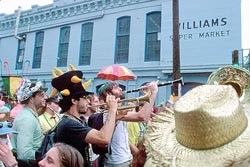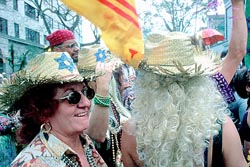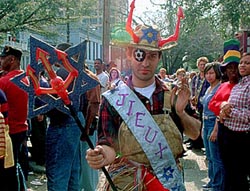Gefilte Fish in the Land of the Kingfish: Jewish Life in Louisiana
By Susan Levitas
Popular culture and history have helped create the idea in the public imagination, that American Jews are northern city dwellers, mostly living in New York, who sound and act like Woody Allen. As southern Jewish historian Eli Evans points out, even northern Jews are hard pressed to believe that Jewish life exists, let alone thrives, south of the Mason Dixon Line. The fact is, over one million Jews live in the South, from tiny towns in Arkansas to booming metropolises like Atlanta. What about Louisiana? Are there Jewish communities around the state, and if so, how did they get here and what have their influences been?
Jewish life in Louisiana has been flourishing, largely under the radar for hundreds of years. While it has become conventional wisdom that Louisiana is the Creole State, with waves of settlement encompassing Native America, Europe, Africa, the Caribbean, and Canada, the story of Louisiana Jews is lesser known. Today, there are over 13,000 Jews in New Orleans alone, and Jewish communities are thriving in small towns across the state. There are Jewish cemeteries in such places as Berwick, Bogalusa, Farmerville, and Opelousas, and Jewish communities exist today in Natchitoches, Baton Rouge, Washington, Monroe, Shreveport, Lafayette, and many other towns.
So, how did Jews get to Louisiana? Several people interviewed responded to this question with a story they had heard, and assumed to be true, about an unknown Jewish peddler who came to their small town. While there, his horse died, so he decided to stay. In fact, hundreds of Jewish peddlers, mostly from Eastern Europe, worked itinerantly around the South. There is a mystique that developed around these early "wandering American Jews." They were seen as industrious and adaptable. They were the progenitors of the landed merchant class that many southern Jews became. The "Jew store," as it came to be known in many communities, was often the one dry goods store in town, and the Jewish family that owned it, was sometimes the only Jewish family in the community. In fact, Jewish life in Louisiana precedes the arrival of 19th century peddlers by hundreds of years. Their arrival in the state continued a trend of Diasporic settlement that has its roots in the first century.
Since the destruction of the Second Temple in Jerusalem in 70 A.D. and the expulsion of Jews from their Promised Land, Jewish communities have emerged and thrived in every corner of the globe. From Shanghai to the Seychelles, Jews were the "eternal strangers" living in a Diaspora that was supposed to eventually end with the return to Israel. Jews learned to adapt, acculturate and assimilate to the life around them, which was often hostile to their presence. They lived with the constant threat of persecution or, worse, expulsion from their new homes. No matter how successful they became, or how prominent they were in civic, political, or social life, there was always the prospect of banishment. This fractured existence was the Jewish way of life the world over for hundreds of years.
The 15th century Spanish Inquisition dealt a stunning blow to Jewish life in Europe, as Jews had risen to unprecedented levels of integration and prominence in European society. It was 1492, the year that Christopher Columbus was "sailing the ocean blue" to America. School textbooks, tell us little about the early colonists, but it turns out that right there on the boats with Columbus, were Portuguese and Spanish Jews-doctors, merchants, and advisors. It would be a couple hundred years before Jewish life was established in America in towns like St. Augustine, Florida, and Savannah, Georgia.
The first Jews came to Louisiana in the early 1700s. They were Spanish and Portuguese traders along the Gulf Coast, who came to this colonial outpost from the Caribbean. Other Portuguese Jewish settlers followed, forming the first Jewish congregation in Louisiana in 1828. Together, these Sephardic Jewish communities comprised the first wave of Jewish immigration to the state. Jewish life thrived, even during the time of the infamous "Black Code" of 1724, which decreed that Jews should be expelled from the Louisiana French colony.
The next wave of Jewish settlement in Louisiana came from Western Europe in the early to mid-19th century. Jews from Germany and Alsace-Lorraine settled in cities and towns all over the state, and brought with them a less traditionally observant practice of Judaism. The French-speaking Alsatian Jews, found a niche in the burgeoning Cajun communities in the southern part of the state, as fur traders who shared a common language. Ury Wainer, an older Jewish fur trader interviewed, described this little-known world of Jewish fur brokering. "We used to go out on the boats for a month at a time. We'd go from camp to camp and buy furs from the Cajun trappers. Then, we'd sell them to the fur dealers. They were comfortable with us because we spoke French."
According to historical researcher Cathy Kahn, Jews "took on the coloration" of the people with whom they settled. So, it was that Hyman Salz, a fifth-generation German Jew from Morgan City, became an alligator fisherman - a prohibited food under kosher dietary laws. His family owned the dry goods store on Main Street, following a trend of Jewish settlement all over the South. As Hyman recalled, "I grew up with swamp mud between my toes." He helped run the family business and sold alligator meat around town. The Jewish community of Morgan City was small, so his family had to bring in an itinerant Hebrew teacher from New Orleans to prepare Hyman for his Bar-Mitzvah. Hyman, like other Jews in Louisiana, felt more a part of the culture than apart from it.
Spike Herzog of Providence, Louisiana, in the northern part of the state, recounts that he did not feel different from his neighbors because of his Jewish identity. As he told it in his North Louisiana-inflected accent, "We didn't feel different because we were Jewish, we felt different because we didn't have two first names. All my friends were Tom Ed and Connie Ray and Bobby Lee. We just had one first name." Like other Reform Jews, Spike grew-up eating seafood and other non-kosher foods indigenous to the region. He had blond hair and fair skin, like his neighbors, and he did not wear a kippah (skull cap), or tsisit (fringe worn under garments) required of more observant Jews, which would have caused him to stand out.
Jews found creative ways to blend the traditions of their neighbors with those of their ancestors. Elaine Schlessinger of New Orleans makes an old family recipe for charoset, which, although blending the Old World with the New South, is not kosher. Charoset is a ritual food item made for and consumed exclusively on Passover, the Jewish holiday commemorating the Exodus from slavery in Egypt 5000 years ago. The dish, a mixture of nuts, apples, honey, wine, and cinnamon, symbolizes the bricks and mortar Jews were forced to make while enslaved. It represents the hardship they suffered as forced laborers, and it is eaten during the Passover Seder meal. Elaine Schlessinger's recipe substitutes Jack Daniels for the sweet Manishewitz wine, used traditionally. She knows that using the grain alcohol makes her charoset non kosher, but it makes her feel connected to her southern roots.
The third, and final, wave of Jewish migration to Louisiana, brought thousands of Eastern European Ashkenazi Jews to the state in the late 19th and early 20th century, bringing with them a more observant, traditional form of Jewish practice. These Jews were part of what Macy Hart of the Institute of Southern Jewish Life refers to as "the Dixie Diaspora." Jews came in through the ports of Ellis Island, New York, and Galveston, Texas, and fanned out across the South. In New Orleans, there was instant friction between these new more Orthodox Jews and their Reform brethren. The Reform Jews were concerned that these immigrants were "too Jewish," and thus would draw unfavorable attention to Jews in general. While Anti-Semitism was not as much a part of the cultural landscape of Louisiana as in other parts of the South, there was still a concern that, as one merchant put it, "we not stand out."
Fitting in was so vital to a Jewish population used to persecution the world over, that stories of "passing" or being fully embraced are common. One such urban legend encountered in many interviews tells the story of a Jewish merchant who was so accepted as part of the larger community, that he was asked to join the notoriously Anti-Semitic Ku Klux Klan. The hero would politely decline the invitation, but he knew that he was selling white sheets to these same men who would use them as disguises. The irony lies in the Jew-hating Klan member unknowingly buying his wares from a Jewish merchant. The story expresses a deep-seated fear of the KKK, as well as a triumphant sense of getting one over on the bad guy. Each teller believed the story to be true, and in most cases, said it happened to a distant relative.

In contrast, the Ashkenazi Jews did not try to fit in and that made Reform Jews very nervous. Ashkenazim tended to settle in small enclaves where they could walk to synagogue on Saturday, so as not to break the Jewish law prohibiting driving on the Sabbath. They ate kosher meat and spoke Yiddish, a creolized Jewish language, blending Hebrew, Russian, and German idioms. The Dryades neighborhood in New Orleans' Lower Garden District was one such enclave of Orthodox Jewish life. There were several synagogues and stores serving this insular community.
In the mid-20th century, Jewish populations moved to the suburbs. Today, only one synagogue remains in Dryades with a handful of older members. Several African American churches have bought the old synagogues, leaving the Stars of David and Menorah carvings on the buildings. As one pastor explained, "We feel honored to be worshipping in the house of God's Chosen People." There are still Orthodox and Conservative Jewish congregations in New Orleans, but most of the Jews are Reform.

Jews in New Orleans have been able to be involved at every level of civic life. Judah P. Benjamin of New Orleans, helped finance the Civil War, and served as Secretary of War and Secretary of State for the Confederacy. (Elaine Schlessinger makes her Jack Daniels charoset in Judah P. Benjamin's old house, which she now owns.) According to Cathy Kahn, Jews were not, however, accepted at the highest levels of society, which in New Orleans means Mardi Gras. "It is a little known fact, that the first king of Carnival - the first Rex, in 1872 - was Jewish. His name was Lewis Solomon. Of course, he was the last Jewish king of Carnival." While Jews are members of the elite Mardi Gras krewes, they are not among the social tiers that represent Carnival royalty. In response to this, a group of Jews got together in the 1990s and created the Krewe du Jieux, a satirical marching club attached to the renowned French Quarter parade Krewe du Vieux. They hand out painted bagels, along with the usual Mardi Gras beads and trinkets.

This cultural parody is set against a backdrop of resurgence in Jewish cultural and religious identification. The first Jewish private school in the state, the New Orleans Jewish Day School, opened in the early 1990s, and several Jewish Film Festivals take place around the state. Synagogue-based gift shops vend a dizzying array of religious and customary items, jewelry, and tchochkes (trinkets). A Jewish Renewal group, full of young members, holds havdalah services, marking the end of the Sabbath, on the banks of the Mississippi River.
To hear many Louisiana Jews describe it, they have found in the South and in this state, a new Promised Land. It is a place that has enabled them to thrive and continue ancient practices without the fear of expulsion. As Cathy Kahn mused, "If Moses had a boat, this is where he would've come."
Sources
Ashkenazi, Elliott. 1988. The Business of Jews in New Orleans, 1840-1875. Tuscaloosa: University of Alabama Press.
Bain, Brian. 2002. Shalom Y'all. Directed by Brian Bain, Produced by Susan Levitas. www.shalomyall.com. A one-hour documentary film about Jews in the South, includes footage in Louisiana from Donaldsonville, Morgan City and New Orleans.
Cohen, Brian. 1998. Pushcarts and Plantations: Jewish Life in Louisiana. Apple West Productions, www.applewest.com. A one-hour documentary exploring the 300 year history of Jews in Louisiana. Louisiana
Evans, Eli N. 1988. Judah P. Benjamin: The Jewish Confederate. New York: Free Press.
_____. 1974. The Provincials: A Personal History of Jews in the South. New York: Athenaeum.
Hinchin, Rabbi Martin I. 1984. Fourscore and Eleven: A History of the Jews of Rapides Parish, 1828-1919, Alexandria, Louisiana: McCormick Graphics for Congregation Gemiluth Chassodim.
Rosen, Robert N. The Jewish Confederates. Columbia, South Carolina: University of South Carolina Press, 2000.
Simons, Andrew. Jews of New Orleans: An Archival Guide. New Orleans: The Greater New Orleans Archivists, 1998.


